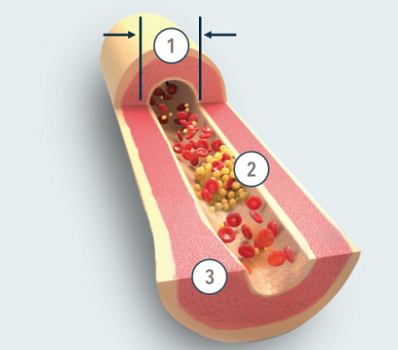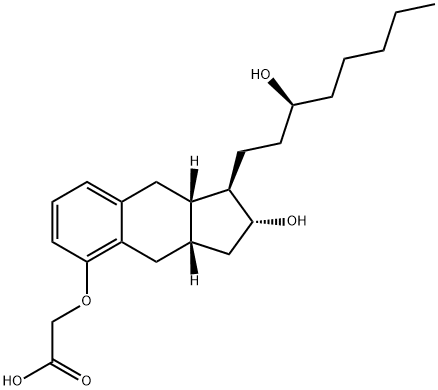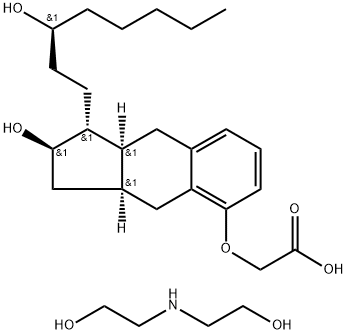Uses
Synthetic analog of Prostacyclin (P839060). Antihypertensive. Treprostinil, marketed under the trade name Remodulin is a medication used to treat pulmonary arterial hypertension (PAH).
Definition
ChEBI: Treprostinil is a carboxylic acid and a carbotricyclic compound. It has a role as a platelet aggregation inhibitor, a vasodilator agent, an antihypertensive agent, a cardiovascular drug, a vitamin K antagonist and a human blood serum metabolite.
Biological Activity
Treprostinil elicits a longer half-life when compared with iloprost. It mediates inhibition of transforming growth factor-β (TGF-β) and nuclear factor-KB (NF-KB) signaling pathways. Treprostinil effectively reduces right ventricular systolic pressure and inhibits the recruitment of circulating fibrocyte.', 'Treprostinil is a stable synthetic analog of prostacyclin (prostaglandin PGI2), an IP receptor agonist used clinically for the treatment of pulmonary arterial hypertension. It is a potent vasodilator with antithrombotic, antiproliferative and anti-inflammatory properties.
Mechanism of action
Pulmonary arterial hypertension (PAH) may be characterized by low levels of endogenous prostacyclin, which is why the prostacyclin pathway should be considered a key pathway for treatment. Treprostinil is a prostacyclin mimetic designed to supplement the endogenous prostacyclin that a patient may not be producing naturally. Treprostinil mechanism of action targets 3 of the major pathologic changes that occur in PAH.
Vasoconstriction: Treprostinil directly dilates pulmonary and systemic arterial vascular beds.
Platelet aggregation: Treprostinil inhibits platelet aggregation.
Smooth muscle proliferation: Treprostinil inhibits smooth muscle cell proliferation.

Pharmacokinetics
Treprostinil is
rapidly absorbed from the subcutaneous site of infusion, with an almost 100% bioavailability and a mean half-life of 85
minutes (34 minutes for the IV infusion). The IV solution must be diluted with normal saline or sterile water before
starting the infusion. Unlike epoprostenol, treprostinil is stable at room temperature for up to 5 years, with vasodilation
action lasting from 4 to 6 hours, compared with the short, 2- to 3-minute action for epoprostenol. Because of its long
life in the body, it can be administered under the skin with a microinfusion subcutaneous infusion pump rather than into
the bloodstream and, thus, without hospitalization, as contrasted with the central IV infusion of epoprostenol.
Clinical Use
Treprostinil is a synthetic, stable form of prostacyclin for the treatment for advanced pulmonary
hypertension with NYHA class III or IV symptoms as well as for late-stage peripheral vascular disease (PVD). Its sodium
salt injectable form is administered either as a continuous subcutaneous infusion directly into the skin or, if the
subcutaneous infusion is not tolerated, as a continuous IV infusion without an implanted catheter.
Side effects
Side effects include jaw pain, headaches, nausea, diarrhea, flushing, and localized pain at the delivery site under the
skin. This pain has been reported as slight to severe irritation. Patients using the drug seem to ex-perience
improvement in their condition, including decreased fatigue, decreased shortness of breath, and decreased pulmonary
artery pressures, as well as overall improvement in quality of life.
Synthesis
A 250-mL, round-bottom flask with a magnetic stirrer was charged with treprostinil diethanolamine salt (4 g) and water (40 mL). The mixture was stirred to obtain a clear solution. Ethyl acetate (100 mL) was added to the clear solution. While stirring, 3M HCl (3.2 mL) was added slowly until pH=1 was attained. The mixture was stirred for 10 minutes, and the organic layer was separated. The aqueous layer was extracted with ethyl acetate (2×100 mL). The combined organic layers were washed with water (2×100 mL) and brine (1×50 mL) and dried over anhydrous Na2SO4. The ethyl acetate solution of treprostinil was filtered, and the filtrate was concentrated under a vacuum at 50° C. to give an off-white solid. The crude treprostinil was recrystallized from 50% ethanol in water (70 mL). The pure treprostinil was collected in a Buchner funnel by filtration, and the cake was washed with a cold 20% ethanolic solution in water. The cake of treprostinil was air-dried overnight and further dried in a vacuum oven at 50° C under high vacuum to afford 2.9 g of treprostinil (Yield 91.4%).





